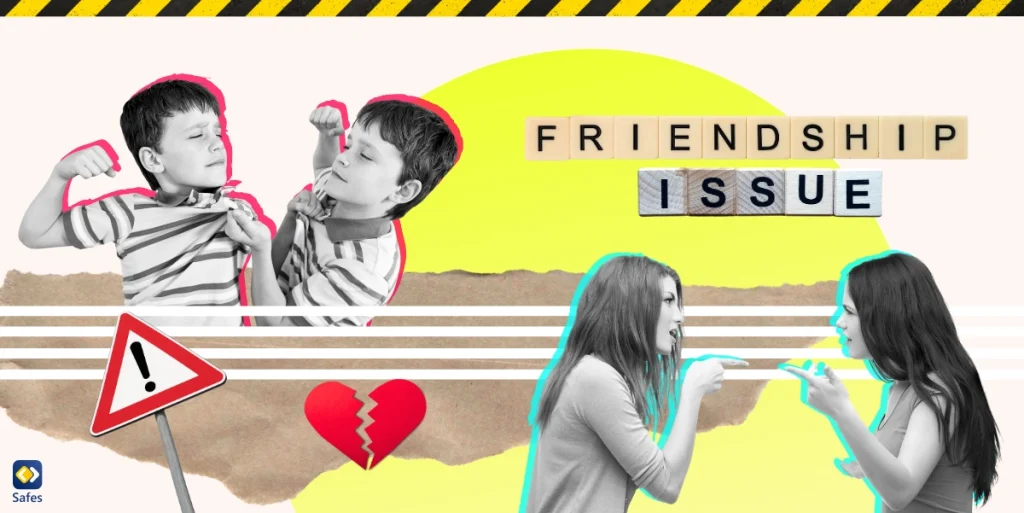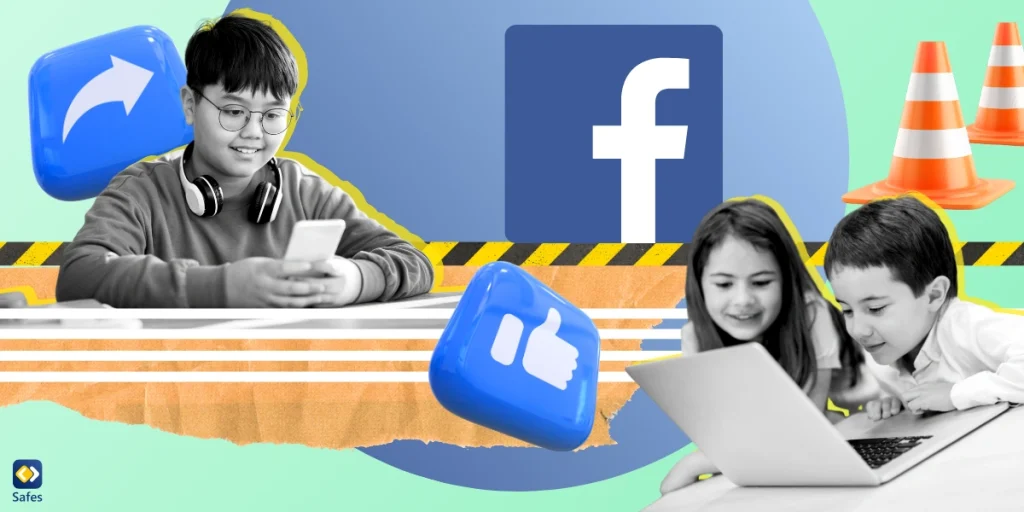Teenage friendships are a crucial aspect of growing up, playing a significant role in emotional and social development. However, not all friendships are beneficial. The topic of teenage friendship issues is often overshadowed by the positives, yet understanding the nuances can significantly aid a teen’s wellbeing.
Download and Start Your Free Trial of the Safes Parental Control App
Emotionally unhealthy friendships can subtly undermine a teenager’s confidence and growth. Recognizing these toxic relationships is vital for parents, as their support can guide teens in navigating these complex social dynamics. This post will focus on identifying signs of such toxic friendships and offer strategies for parents to help their teens.
Teenage Friendships: What Are They?
Teenage friendships are often marked by their intensity and can be profoundly influential in a young person’s life. Good friends play a pivotal role, providing emotional support and helping with identity formation. Healthy friendships are characterized by mutual respect and the ability for both parties to feel comfortable and supported. They are a safe space where teens can express themselves freely and develop crucial social skills.
However, not all friendships offer these positive experiences. Traits of a bad friend can emerge subtly, showing up as signs of a frenemy—someone who pretends to be a friend but actually harbors resentment or envy. It’s essential for teens and their parents to be aware of these dynamics. Paying attention to how a friendship makes a teen feel is key. If there is constant stress or discomfort, it might be time to reevaluate the relationship. Recognizing these signs early can prevent emotional distress and promote healthier social interactions.
What’s the Deal with Toxic Friendships?
Toxic friendships are those that consistently leave you feeling drained, diminished, or disrespected. They can occur in person or within online friendships, each environment presenting unique challenges. The core of these relationships involves repeated patterns of negativity, manipulation, and a lack of empathy.
Recognizing the Red Flags
Here’s a rundown of the most glaring signs of a toxic friend:
- Constant Negativity: Every interaction seems to dip into criticism or pessimism.
- Manipulation and Gaslighting: Twisting words, situations, or emotions to benefit themselves at your expense.
- Disrespect: Regular comments or actions that undermine your self-esteem.
- Peer Pressure: Forcing or coaxing you to do things you’re uncomfortable with.
- Passive Aggressive Behavior: Subtle digs or backhanded compliments that leave a sting.
The Fallout
The impact of toxic relationships on teens can be profound:
- Mental Health: Toxic friendships can lead to anxiety, depression, and low self-esteem.
- Academic Performance: The stress and distraction may cause grades to slip and school engagement to wane.
- Other Relationships: Negative interactions can spill over, affecting the teen’s relationships with family and other friends.
Understanding these dynamics can empower teens and parents to take action, ensuring that friendships enrich, rather than drain, their lives.

How Parents Can Help
Navigating teenage friendships can be complex, but as a parent, your guidance is key. Here’s how to start.
Open Conversations
Initiating a dialogue with your teen about their friendships can be tricky; it’s important not to seem intrusive. Start by sharing observations without judgment. Ask open-ended questions that encourage your teen to express their feelings and experiences. Be a listener, not an interrogator, especially when discussing sensitive issues like high school cliques or red flags in friendship.
Promoting Healthy Socializing
Encourage your teen to expand their social circle and participate in various group activities that foster healthy interactions. This might involve joining clubs that align with their interests or sports where teamwork is key. Highlight the value of diverse friendships over social media-centric relationships, which can often distort social dynamics.
Leading by Example
As parents, your own relationships are a powerful teaching tool. Demonstrate healthy communication and conflict resolution with family members and friends. Let your teen see how you manage disagreements without making the other person feel guilty, which sets a solid example for them to emulate in their own friendships.
Spotting Warning Signs
Equip your teen with the knowledge to identify warning signs in their friendships. Discuss what behaviors constitute a toxic relationship, such as a friend who often makes them feel bad about themselves. Encourage them to trust their instincts—if a friendship constantly feels draining, it may be worth reevaluating.
Empowering Your Teen to Make Positive Choices
Empowering your teen to recognize and manage toxic friendships independently is crucial. It’s like giving them the map to navigate the tricky terrain of teen relationships. Discuss how a true friend should make them feel good, not drained, and highlight the importance of understanding friend red flags.
Teach your teen to set boundaries—a skill that’s as essential as learning to text with one hand! Encourage them to know their worth and expect the same respect they offer. A real friend respects these boundaries without making them feel guilty.
Have candid discussions about what characteristics define healthy versus toxic friendships. Use clear examples: a healthy friend cheers you on, while a toxic one might drown you in negativity. Remember, social media is toxic when it distorts these realities, making it harder to see the line between supportive and harmful.
Role-playing can also be an effective and fun way to prepare your teen to handle tough social situations. Create scenarios where they practice responding to peer pressure or dismissive comments.

Understanding the Impact of Friendships on Adolescent Mental Health: A Recent Study
A pivotal study by Manchanda, Stein, and Fazel, published in 2023, investigated the role of friendship-based interventions in enhancing the mental health outcomes of adolescents. This comprehensive research included a scoping review of 24 studies and a systematic review of 18, analyzing data from 12,815 adolescents aged 12–24 years. The findings highlighted three major themes: promoting mental health literacy, supporting help-seeking behaviors, and fostering friendship-building to combat isolation.
The most notable results indicated that interventions focusing on friendship-building yielded positive short-term mental health outcomes. However, the long-term effects remained inconclusive, suggesting a need for ongoing support and evaluation. Furthermore, the research underscored the essential role friends play in adolescents’ mental health, particularly as primary support contacts during challenging times. This study emphasizes the potential of integrating friends into mental health interventions to leverage these relationships for better well-being outcomes among teenagers.
The study not only sheds light on the effectiveness of friendship-oriented approaches but also calls for a deeper understanding and implementation of such strategies in mental health programs for adolescents
Meet Safes: Your Parental Control Ally
Introducing Safes, the parental control app designed to keep an eye on your child’s digital life, so you don’t have to hover. Safes helps manage and monitor how much time your teen spends online—because sometimes, you need a little backup to enforce bedtime.
With features like activity tracking and time limits, Safes gives you the power to ensure your teen’s digital interactions are healthy without being invasive. Monitoring social media use and managing app access helps you set boundaries digitally, mirroring the rules you set in the real world.
Ready to take control? Download the Safes app available on both iOS and Android. It’s a straightforward way to make sure your teen’s tech use is balanced, like making sure veggies are on their plate—a necessary, if sometimes unpopular, part of parenting.
Not sure if Safes is right for you? Thinking parental controls on Android give you enough options? Give Safes a go with a free trial. It’s like a test drive for your peace of mind, allowing you to see if our app meets your family’s needs before fully committing. Let Safes help you help your teen navigate their digital world more safely.
Wrapping It Up
As we’ve explored, recognizing the signs of toxic friendships—like constant negativity or pressure from so-called close friends—is crucial for helping your teen navigate their social circles safely. Parental guidance plays an indispensable role in guiding them away from harmful relationships and towards nurturing, positive interactions.
By utilizing tools like Safes, you gain more than just oversight—you gain a way to subtly guide your teen’s digital and real-world interactions. These tools can help you ensure that your teen’s friendships are contributing positively to their growth and well-being, keeping the digital doorway to toxic influences firmly managed.
Your Child’s Online Safety Starts Here
Every parent today needs a solution to manage screen time and keep their child safe online.
Without the right tools, digital risks and excessive screen time can impact children's well-being. Safes helps parents set healthy boundaries, monitor activity, and protect kids from online dangers—all with an easy-to-use app.
Take control of your child’s digital world. Learn more about Safes or download the app to start your free trial today!




